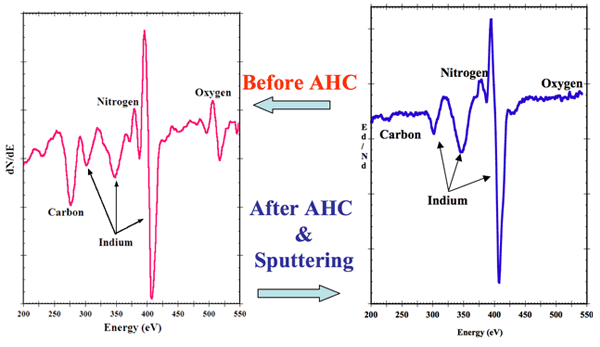Auger Spectrum of Indium Nitride Surface
The Auger effect may be used in surface studies. The measurement of the characteristic energies of the Auger electrons can be used to identify the atoms residing on or near the surface of a solid material. The spectra below involve measurement of the number of electrons from the surface as a function of energy while bombarding with an electron beam of fixed energy.

Using Auger spectroscopy to verify the effectiveness of a surface-cleaning operation.
In his studies of the surfaces of indium nitride thin films, Rhudra Bhatta used Auger electron spectroscopy to detect the presence of contaminants on the surface and to confirm the effectiveness of measures to remove those contaminants. The Auger spectrometer bombarded the surface with 3000 eV electrons, which removed some inner electrons from the atoms near the surface. Although the atomic energy levels of the atoms are significantly perturbed by the presence of other atoms in the solid, they are still characteristic of the chemical elements and enable one to detect the presence of atoms of those elements.
Having detected the presence of carbon and oxygen atoms on the surface in addition to the intended indium and nitrogen, he bombarded the surface with hydrogen atoms in a technique called AHC or "atomic hydrogen cleaning". This removed the oxygen effectively but left some residual carbon. A second treatment with a brief period of "sputtering" with atoms from a hot filament. The Auger spectroscopy confirmed the effective removal of the carbon and oxygen contaminants.
Atomic Structure Concepts
Reference
Bhatta
| HyperPhysics***** Quantum Physics | R Nave |